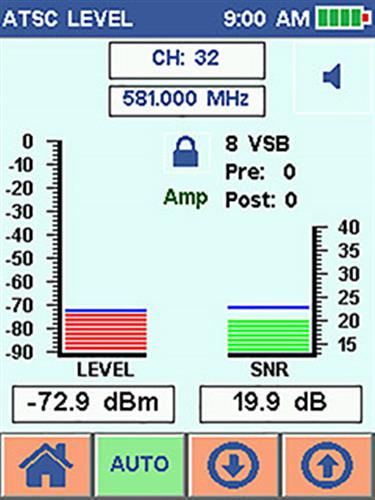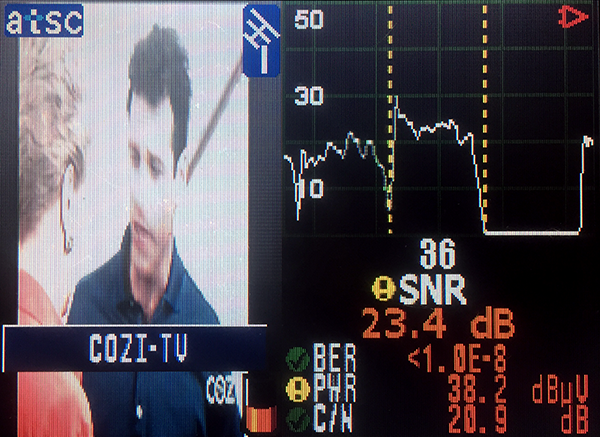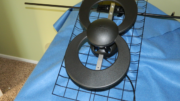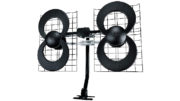It’s hard for a DIY-er to know what sort of antenna is really best for his or her location. In fact, it’s so close to impossible that we often describe antenna selection as more of an art than a science. The professionals at Solid Signal can help with a free recommendation if you call 888-233-7563, but even that is really a very educated guess based on information about your general area. In order to really get a 100% understanding of what kind of antenna you need, you would actually need to have some pretty sensitive equipment to understand what is going on.
The image at the top of this article comes from a Televes portable spectrum analyzer. Technicians all over the world use this meter to install cable, antenna, and satellite television, and it is the absolute cream of the crop when you’re talking about satellite meters. It will also run you about $6,000, so it’s not likely to be something the average DIYer is going to have lying around. But let’s take a look at what it’s displaying and see why every measurement is important, why one measurement is more important than others, and why it’s not the one you think.
Live TV
Obviously all the numbers in the world won’t help you if you’re not actually receiving a live TV picture. Here we see a good live TV picture (it’s intentionally distorted) with no blockiness or other problems.
Signal Strength (and gain)
This is the measurement most DIY-ers use to decide what sort of antenna to choose. Signal strength itself is usually measured in dBµV or dBm, which are measurements of signal voltage or signal wattage. Both are consistent with each other as long as the same cable is used. In the screen above, the signal strength is listed as 38.2dBµV (.00008 volts). Believe it or not, while that’s not “great” it’s actually usually good enough to get a good picture.
Most people tend to buy an antenna based on its “gain,” which is a measure of how much more signal it can pick up compared to laboratory reference data. However, gain can fool you, and as you see in the picture, even a weak signal can give you a good result.
Bit Error Rate
This is one of the more important ways of measuring digital signals. It tells you how much of the signal you’re receiving is total rubbish. If you had a high bit error rate, it could be due to interference by trees or something else in the way of your antenna. In this case, the Bit Error Rate is measuring less than 1/1,000,00,000 so it’s clear that the signal that is coming in is nice and clean. If it were high enough to cause problems, you would see picture freezing and you would probably want to move your antenna out of the way of whatever is blocking it.
Carrier to Noise Ratio
Carrier to Noise ratio and Signal to Noise Ratio are very similar measurements. They both tell you something similar… how much stronger the antenna signal is than the noise that surrounds it. Carrier to Noise ratio, abbreviated C/N in the image above, is the less important measurement because it only tells you about the “carrier,” which is the very basic form of the television transmission. It doesn’t tell you about the “signal” which is really the part you want, because it’s the part that actually gives you a live picture. In the image above the C/N is good enough. Higher numbers are better here.
Signal to Noise Ratio: The thing you really need to pay attention to
Signal to Noise Ratio, abbreviated SNR in the image above, is what you actually need to pay attention to. It’s the one number that tells you whether you’re going to get a live TV picture. The image above tells me the SNR is weak, meaning that if I add another splitter or too much cable, I might lose my live TV picture.
If SNR is so important, why don’t antennas tell it to me?
So here’s the problem. SNR is really the most important measurement when looking at which antenna is best for a situation. However, it’s not really a measure of the antenna, it’s a measure of the situation. A person using the same antenna in two different areas will have two different SNRs. Trying to pick up two different channels will have two different SNRs.
…and here’s the dirty little secret — adding an amplifier improves the signal strength and sometimes makes the SNR worse. Everything you add to a line adds noise, so if you’re not providing enough amplification to overcome the noise you’re adding, an amp will give you fewer channels.
Here’s what “regular folks” can do.
Obviously you’re not going to buy a $6,000 meter to install one antenna. However, you might be coaxed into buying a meter for under $400. You can even share the expense with other people who are thinking of cutting the cord. The SignalScout doesn’t have a lot of the very fancy features of the Televes meter. Still, it does give you signal strength and SNR, in a somewhat less entertaining way.

Here’s the idea. Combine this with an inexpensive portable TV and a super-cheap antenna. That way you’ll have a passable antenna testing rig for well under $500. That cheap antenna probably won’t pick up much, it’s true. But, it will be enough to see if your SNR is anywhere close to where it should be.
How to choose the right antenna for you
This is a very —very— broad set of suggestions. If you’re going to go about this scientifically, it will at least set you on the right road.
- If the signal strength is too low, get a bigger antenna.
- If the carrier-to-noise is too low, get a super-low-noise amplifier.
- If the bit error rate is too high, you’ll need to put the antenna up high on the roof.
Or… you could start with an outdoor antenna. Choose one with built-in low noise amplification, strong gain, and solid construction. That way it will hold up in the elements. For that, there’s only one choice: Televes.
Televes antennas come in a variety of shapes and sizes including one small enough to be used indoors. They’re designed and built better than the competition. Since you’ve gotten all the way to the bottom of this article, chances are that’s important to you. You can get Televes antennas at SolidSignal.com, and believe me, you’ll be glad you shopped. If you have other questions, just call us at 888-233-7563 or fill out the form below.




